Not being the brightest bulb in the universe and even though I've been climbing peaks in Japan for the past 2 decades, it wasn't until just a year before this trip that I first heard of Mt. Notori-dake (農鳥岳, elev. 3026 m) or Mt. Nishi-notori-dake (西農鳥岳, elev. 3051 m). Nor until early 2011 had I ever heard of the Shiranesanzan (白根三山, "3 white summits"), comprised of Mt. Notori-dake (農鳥岳), Mt. Kita-dake (北岳), and Mt. Ai-no-dake (間ノ岳) in the Southern Japan Alps (南アルプス). 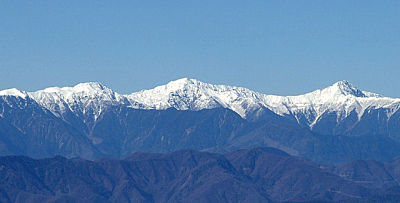 Shiranesanzan (白根三山) - "3 white summits" Mt. Notori-dake (農鳥岳), Mt. Ai-no-dake (間ノ岳), and Mt. Kita-dake (北岳) (L to R) (photo courtesy: Wikipedia) And embarrassingly, in August 2010 after scaling Mt. Jonen-dake, I proudly proclaimed that I had climbed all of Japan's 25 highest mountains. Oops! Mt. Nishi-notori-dake (西農鳥岳), the not-so-exciting higher of the Notori-dake twin peaks, is in fact the 15th highest mountain in Japan. My big mistake was using a list of what I THOUGHT was the highest mountains in Japan that a friend had downloaded from the internet back in 1998, and from which I had been checking off peaks ever since. Problem is.....because my list is written in Japanese (not my forte), as it turned out, my list was actually a ranking of the highest Nihon Hyakumeizan (日本百名山, Japan's 100 Famous Mountains). OMG!  So the main purpose of this climbing trip was to scale Mt. Nishi-notori-dake (西農鳥岳), so I could now accurately proclaim to have in fact climbed all of the highest mountains in Japan, as well as all of the 21 Japanese peaks known as the Three-thousanders (日本の山一覧 (3000m峰), peaks over 3000 m high). This climbing trip turned out to be an awesome venture, with almost perfect weather (albeit a tad toasty, even getting a bit sunburned on the first day), and was a kind of a homecoming of sorts for me, as it was my third time to climb Mt. Kita-dake (北岳, Japan's 2nd highest peak) and my second time to climb Mt. Ai-no-dake (間ノ岳, Japan's 4th highest peak). Day 1 – Fri. August 12, 2011Leaving Shinjuku Station on Thursday, August 11, 2011 at 11 pm on limited express train Kaiji 123, I arrived at JR Kofu Station at 12:40 am, where I had to wait around for my 4 am Yamanashi Kotsu bus to the Hirogawara (広河原) trailhead. After the little over two-hour bus ride, I was able to start hiking by 6:20. The first few hours of hiking up the Okabasawa (大樺沢) Valley toward Futamata (二俣) was quite enjoyable, passing through the beautiful forests and crossing the Okabasawa mountain stream (大樺沢) a number of times. The beautiful contrast between the clear blue sky, green forest, white snowfields, and gray rocks was quite striking, as you can see below: 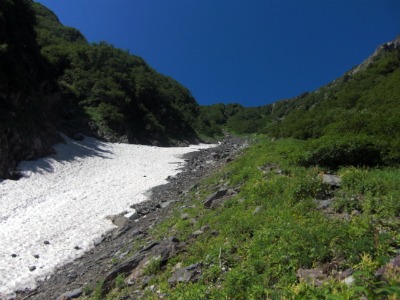 The beautiful Okabasawa (大樺沢) Valley After ascending above the tree line around Futamata (二俣) (~elevation 2200 m), things started heating up with the direct sun exposure. The trail gets progressively steeper, where eventually you'll encounter something which I have never seen quite to this extent anywhere on any other trail in Japan. A series of over 20 ladders have been installed to assist your climb, both below and above Happonba-no-koru (八本歯のコル) (~elevation 2850 m). This is where the trail coming up from the Okabasawa (大樺沢) Valley intersects the Ikeyama-tsurione hanging ridge (池山吊尾根). The next trail junction is for the Mt. Kita-dake (北岳) summit trail and if you're headed toward the Kita-dake-sanso mountain hut (北岳山荘) (as I was), this is a good place to drop your heavy pack while you trek up to the summit of Japan's second-highest peak. From here it should take you only 30 min. to the top (it took me 45 min., even with NO pack, as I was TOTALLY wiped out after negotiating all those ladders).  In all fairness, this is a fairly rigorous workout, as you'll gain over 1660 vertical meters from Hirogawara (広河原) to the summit of Mt. Kita-dake (北岳), compared to only 1470 vertical meters from the Fifth Station to the summit of Mt. Fuji (富士山) on its main Yoshida trail. The views from Mt. Kita-dake's (北岳) summit are stunning, where on a clear day you can see Mt. Fuji (富士山), Mt. Yatsu-ga-take (八ヶ岳), Mt. Kai-koma-ga-take, Mt. Senjo-ga-take (仙丈ヶ岳), Mt. Ai-no-dake (間ノ岳), the Chuo Alps, and if you're lucky, even as far as the Kita Alps. After you go back down to claim your pack, it’s 50 min. over to Kita-dake-sanso (北岳山荘). The traverse section of this trail from Happonba-no-koru (八本歯のコル) will be worth a few adrenaline rushes, with all the ladders and stairs attached to the vertical walls, as you can see here: 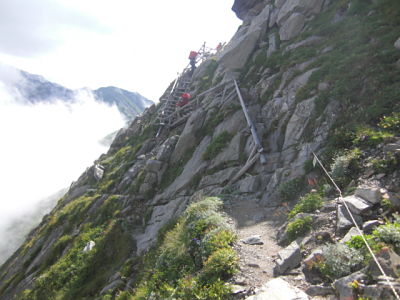 Traverse from Happonba-no-koru (八本歯のコル) Kita-dake-sanso (北岳山荘) is a very well-run mountain hut where I spent two nights. Food was great, the staff was delightful (and spoke a little English), and the toilet system (its own separate building) was the cleanest and most modern I've seen anywhere in the Japan Alps. And hey, they even had a pay phone.  My original plan was to make it over to the Notori-goya mountain hut (農鳥小屋), where I would be within a much closer striking distance of Mt. Notori-dake (農鳥岳), but my hiking speed was too slow on this first day. And on the next day, after seeing up close and personal the terrible condition of Notori-goya (農鳥小屋), boy was I ever glad I didn't stay there! As it turned out, my hiking trip this year coincided with the Perseid meteor shower, but unfortunately the full moon kept me from seeing more than just a handful of shooting stars. Day 2 – Sat. August 13, 2011The agenda for this day was very simple….to climb Mt. Notori-dake (農鳥岳), and to make it safely back to Kita-dake-sanso (北岳山荘). A day hike with a very light day pack. Yay! A day hike with a very light day pack, but NOT easy. Up 300 m past the not-so-interesting Mt. Nakashiranesan (中白峰山) to Mt. Ai-no-dake (間ノ岳), down 400 m to Notori-goya (農鳥小屋), up 250 m to Mt. Nishi-notori-dake (西農鳥岳), down 100 m to the saddle, and then 75 m back up to the summit of Mt. Notori-dake (農鳥岳).... and back the same way. 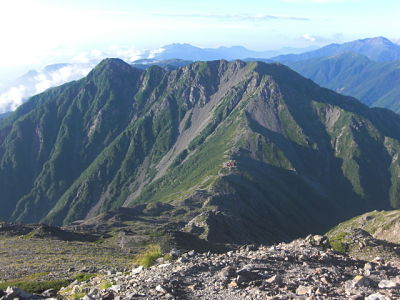 Mt. Notori-dake (農鳥岳) (L) Mt. Nishi-notori-dake (西農鳥岳) (R), from Mt. Ai-no-dake (間ノ岳) Ordinarily, I don't think this would've been too much of a problem, but because I was still so wiped out from the day before, this "easy" day hike took me nearly 12 hours (even with just a day pack), including all my breaks plus lunch on top of Mt. Notori-dake (農鳥岳). Ugh! And I must say, Mt. Nishi-notori-dake (西農鳥岳), Japan's 15th highest mountain, was quite a disappointment….in fact so much so that I didn't even bother taking a pic of it. It's nothing more than a tiny pile of rocks, and without any kind of marker. I was thinking to myself, "I'm spending three days of my life to come ALL the way over here to see THIS?"  But there were awesome views of Mt. Fuji (富士山) along this route, especially just before sunrise, and Mt. Shiomi-dake (塩見岳) to the south was clearly visible from the summits of Mt. Ai-no-dake (間ノ岳) and Mt. Notori-dake (農鳥岳). Oh, and while I was atop Mt. Ai-no-dake (間ノ岳), I experienced a rather interesting phenomenon for the 1st time in my life.....something known as a "Brocken spectre," named after a peak in the Harz Mountains in Germany, where it apparently occurs frequently. It was a bit foggy at the time with the sun only poking thru sporadically, and then suddenly one of the other climbers pointed out this very unusual circular rainbow, where I could see my shadow right in the middle of it. My 2 pics I took didn't turn out, but the Brocken spectre I saw appeared somewhat like this pic taken in Japan's Tanzawa Mountains: Although the college student staff were very cordial, I was very unimpressed with Notori-goya (農鳥小屋). In all due respect, it is without question one of the most unattractive mountain huts I've ever seen in the Japan Alps, its toilet was disgusting, and it is in need of a serious makeover. I only spent 5 min. there in each direction….just long enough to buy a ¥500 Coca-Cola Zero….and am VERY thankful I didn't stay there overnight. Day 3 – Sun. August 14, 2011My final day in the Southern Japan Alps (南アルプス) was basically just a long hike back down to civilization, winding up in Hirogawara (広河原) where my three-day venture had started on Friday. This day started out beautifully, with one of the most awesome sunrises and striking views of Mt. Fuji (富士山) that I think I've ever seen. Some of my pics turned out fairly well, so one of my Facebook friends encouraged me to enter two of the better ones in a photo competition. Here is one of them: The trek back to Hirogawara (広河原) was fairly uneventful (I hated going down all those ladders!), except for the delightful surprise of seeing an entire colony of Japanese mountain monkeys down below the aforementioned traverse just below Mt. Kita-dake (北岳), on the route from Kita-dake-sanso (北岳山荘) over to Happonba-no-koru (八本歯のコル). At first I spotted just three or four monkeys, but after closer inspection I saw probably a total of 15 to 20 of them roaming around about 100 m down below the hiking trail. I don't recall ever seeing this many wild monkeys in one place anywhere in the Japan Alps. I started hiking that day shortly after sunrise around 5:15, and just after stopping briefly @ the Hirogawara-sanso (広河原山荘) to buy a Coca-Cola Zero from their vending machine, I arrived at the Hirogawara (広河原) bus terminal at 11:15, where I encountered a stroke of good luck. The next bus for JR Kofu Station was not scheduled for departure until 12:45 pm, but after milling around the bus stop for only a few minutes, one of the taxi van drivers approached a few of us and asked if we would like to take his 8-passenger taxi van to Kofu for the same price as the bus – ¥2000. Well, of course we jumped at the offer, departing Hirogawara (広河原) at 11:35 and arriving at JR Kofu Station at 1:00 pm, a full hour and 40 min. earlier than the 12:45 bus was scheduled to arrive there. Wow, what a time savings. My only regret in my rush to get back to Kofu is that I didn't have time to check out the very modern-looking Alpen Plaza Hirogawara (アルペンプラザ広河原) information center located right next to the Hirogawara (広河原) bus terminal. My Mt. Notori-dake (農鳥岳)
|
 A FREE download at Smashwords 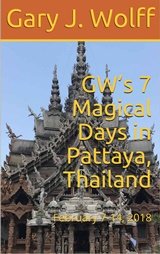 Only $1.99 at Amazon (¥214 at アマゾン日本) 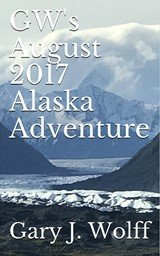 Only $2.99 at Amazon (¥340 at アマゾン日本)
Japan Mountain Pages: 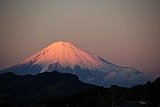 Climbing Mt. Fuji - FAQ 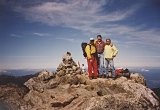 Mt. Kita-dake 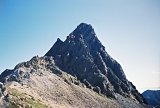 Mt. Oku-hotaka-dake & Mt. Yari-ga-take
|
||||||
|
 Only 99¢ at Amazon (¥114 at アマゾン日本) 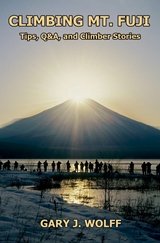 Only $2.99 at Amazon (¥343 at アマゾン日本)  Only $2.99 at Amazon (¥343 at アマゾン日本)
What's New?
|
|||||||
|
|
|||||||

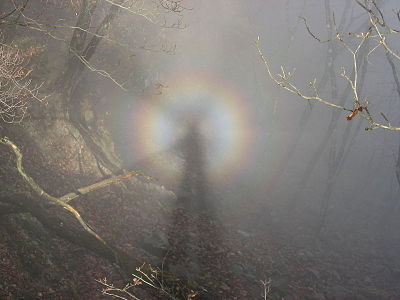
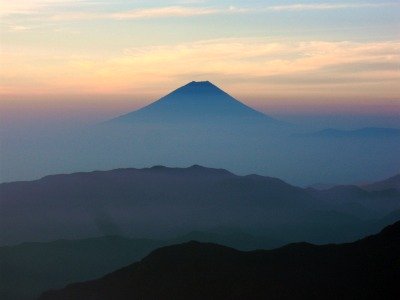
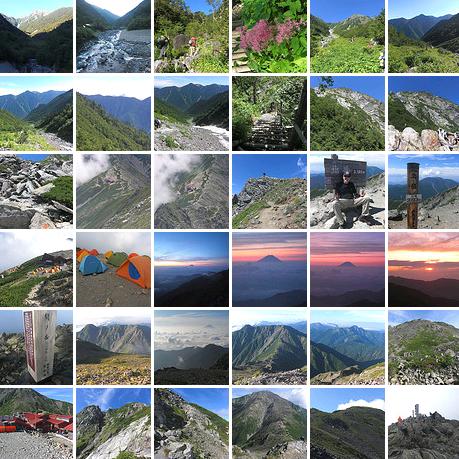
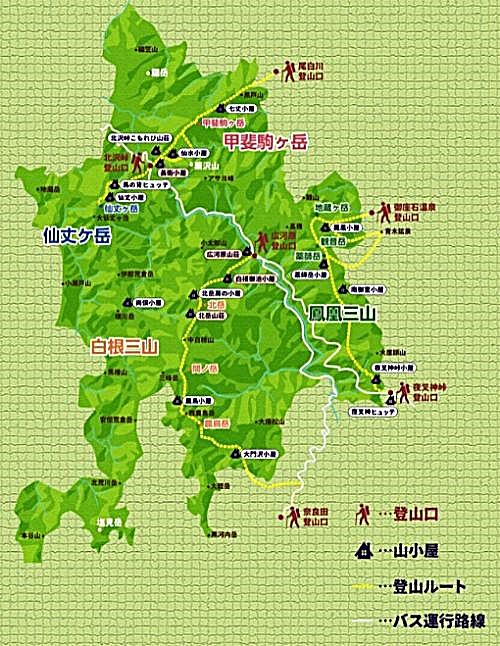


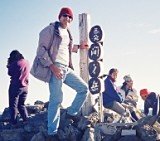
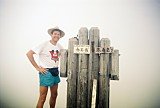
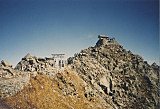
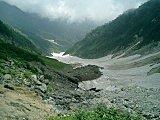
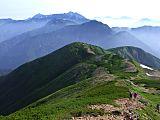
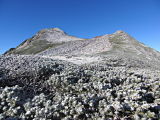
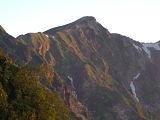
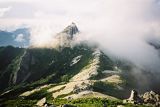
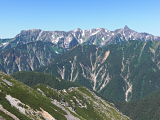


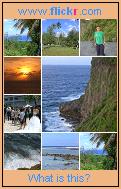

New! Add your comment
Have your say about this page! Feel free to comment in the box below: